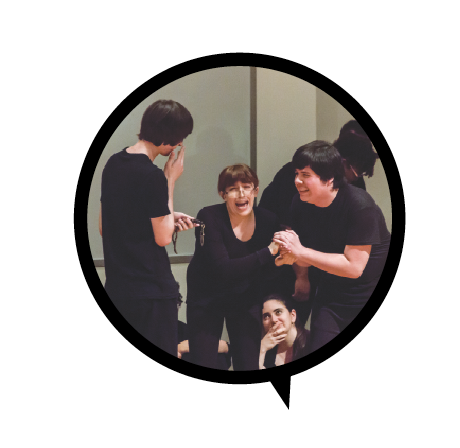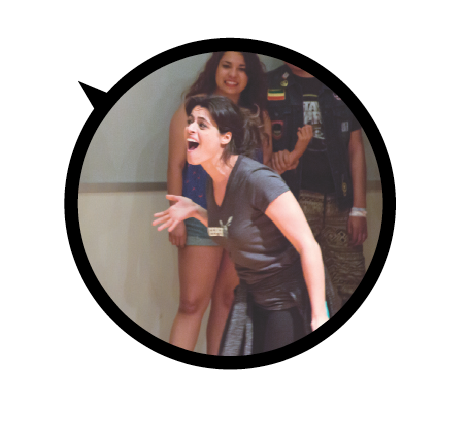Improv course, professor encourages personal growth through art of comedy
For an hour every Monday and Wednesday, Kathy Lingo welcomes her improv classes into the state of crazy – as she calls it – a place that bursts with energy and expression, frees the brain and liberates the soul and heart.
“The way we condense our world now is we go to class, have meetings, have our jobs and go home, but when do we get to explore that part of our brain that the real humor or spirit of life comes from?” Lingo said. “We need that mental release.”
Improv, the form of theater where almost all of what is performed is created at the spur of the moment goes back centuries. Before people began writing scripts, they were telling stories by acting them out.
Lingo, who has been teaching improv classes that are open to all majors since 2008, says that no one skit is alike because nothing is ever scripted.
“The reason why improv is so important to me is because of the way that it stimulates the creative brain,” Lingo said.
On April 15, Lingo’s Improv I and II classes hosted a comedy show at the Jonsson Performance Hall, where the students performed their favorite improv scenes from class.
“The only thing I can promise is if we didn’t offend you, please sign a card out front, so we make sure we get you next time,” Lingo said.
And the students will keep their clothes on, Lingo reassured the crowd.
She introduced the topics, followed by an “and scene,” and the show took off. Improv I performed first with the topics “theft: jewelry store,” “children: Lost Boys,” “conflict,” “geriatric” and “silent crime.”
An Improv I student, senior Emily Joyce, portrayed three characters during the show. The arts and performance student brought to life the characters of Mickey Mouse, the Road Runner and a bad cop who likes donuts a little too much.
An important part of developing these characters was mastering the voice, Joyce said. While growing up, Mickey Mouse, the Road Runner and Alvin and the Chipmunks were all characters she enjoyed watching and imitating.
“For Mickey, I made sure to have a funny looking walk, something that says ‘character’ to the audience and makes them laugh,” Joyce said. “But the voice is the key to playing him.”
The Basics of Improv
In the first six weeks of Improv I, Lingo teaches the fundamentals of improv, including the 14 rules students learn and channel.
The first rule is to never say no to what other actors are saying but to just go with it. Other important rules include listening to what other members are saying without speaking over them, projecting vocally and avoiding the blocking of others while performing. 
Each class, Lingo assigns a different topic. The topic can be anything, as long as it can be used to create a good story. Lingo said it is important to know what constructs a story, the environment, conflict and since it is a comedy, the bigger conflict.
“We have these perceptions of the way the world is supposed to be, and improv is about breaking what we expect to happen and so we laugh,” Lingo said.
Improv has always pushed Joyce to take a different, less predictable path.
After college, Joyce has many dreams she hopes to achieve, but nothing is fixed, she said, and that is the beauty of it. She started performing at the age of 10, after her mom took her to plays as a child.
One of her dreams is to try out for The Groundlings, an improvisation and sketch comedy theatre in Los Angeles, and to start doing improv with the professionals on SNL.
“Dreams make us reach for the unattainable and strive to attain it, but often leave us with the horrible sense that we have no direction in life,” Joyce said. “The truth is we have many different options open to us and it is perfectly okay — a little bit frightening but okay — that I have absolutely no idea what I am doing after college.”
But the uncertainties in the future and even in the upcoming skit topics are all a part of what set apart improv from other theatre forms. Not knowing the topics makes it more important to just live in the moment and truly listen to what the other person is saying, Lingo said.
One class was dedicated to “elderly day,” where everyone takes up a role that is 65 years or older. Another class was “children’s day,” where the focus falls on achieving a unique childlike quality and playfulness.
At the beginning of the course, Lingo spends time with students observing people, but not to criticize them, she said. They look at people to love them and to identify what makes them different.
The Brooklyn cop Joyce portrayed during the show was inspired by her visit to New York, when she spoke with a heavily-accented Brooklyn police officer. Since their encounter, Joyce has been working to perfect that accent.
Lingo goes over how human beings walk and how to act out varying body configurations. On-stage, the role of nobody won’t cut it, Joyce said. Quirks, ticks or body isolations can add character, whether they are limps or the pelvis thrusting all the time.
Like in a regular conversation, it is important to take a “beat” or a one to two second pause before producing the character’s response during improv, Joyce said.
“You think ‘easy enough,’ but then you get up on-stage in front of an audience and there is a certain adrenaline and energy that comes to you, which makes you believe everything you are doing at this moment in time is at a snail’s pace,” Joyce said.
But after many performances, Joyce said she knows the snail’s pace is in reality a relatively normal speed that she must fight to stay at.
Every skit is dissected and Lingo models the walks, the voices and the timings, demonstrating the different ways they could have performed each part.
In delivering lines, timing is everything, Lingo said.
“If you’re two seconds too soon or two seconds too late, you’ll lose the audience and you’ll lose the laugh,” Lingo said.
Improv II
As the students move to Improv II, they take what they have learned in Improv I to a completely new level, said arts and performance major senior Tyler Anglim. He said Improv II centers on creating complex stories.
“I like the scenes where people feed off of each other,”Anglim said. “I’m all about working with other people.”
In the future, Anglim said he plans on working at improv nightclubs, while theater major senior Chinweolu Greer hopes to become a stage director and work in community theater with kids.
As a kid, Greer was very shy and had a speech impediment. Her speech instructor had her speak in front of people, which essentially helped her build confidence and gain the ability to communicate well, Greer said. 
The first semester Greer started working, she sat in on Lingo’s improv class.
“Kathy threw me in the circle to start playing around and improv has been my guilty pleasure ever since,” Greer said.
Working as an event coordinator for the school of Arts and Humanities serves as some of Greer’s inspiration during improv class.
“I have a bank of conversations of interesting people that have left a weird imprint on me that I can pull up,” Greer said. “Sometimes it’s funny, and sometimes it’s not, but at least I tried it.”
Greer and Anglim were a part of the Improv II comedy show. Their segment included scenes revolving around the topics “check out line,” “children and superheroes,” which resulted in Pokémon, and “pick up.” After intermission, students continued with the topics “safety: CPR,” “Noah,” “superheroes: Captain Allergen,” “easy rider,” “hand sale/sell” and “Subway.”
After the show ended, anyone from the audience was invited to come on stage, and give improv a try.
The end goal of the class aims at eventually developing trust with team members. More than that, Greer said it is to enjoy this hour to let go, live in the moment and laugh with each other.
“The hardest thing about improv is letting your guard down, but be okay with playing and looking silly because I guarantee you there are four people who look sillier than you,” Greer said.
In the final scene “Subway,” Improv I joined Improv II on the stage, as everyone chimed in to create music. This is a human band, Lingo said, one where everyone carries a tune in his or her soul.
There was one person on the Subway who brought in a cacophony of sounds. He didn’t harmonize the way the others did. The rest of the Subway civilians noticed, but invited him into the center of their musical group.
“Everyone has a place,” Lingo said at the end of the scene.
Leave a Reply